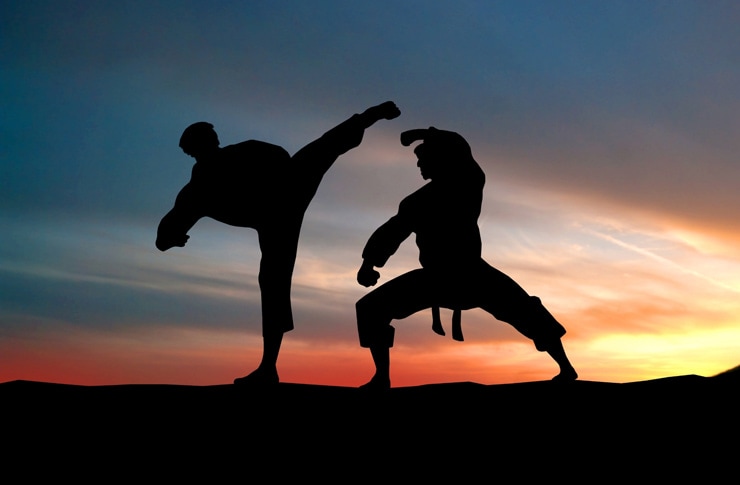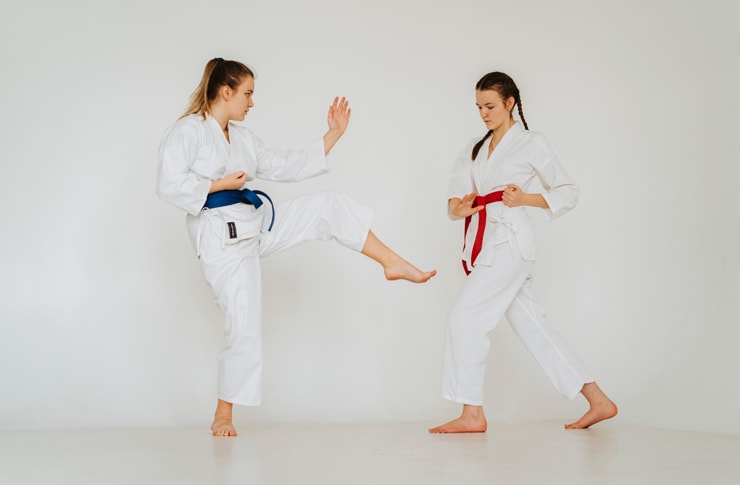
When most people think of karate, they picture a broad range of fighting movements and ninja skills. However, the moves you may see in the movies could be a combination of different karate types and styles.
Karate is a group of different Japanese Martial Arts. Below we’ll explain the 11 types of Karate.
Four traditional karate types were initially developed in Japan. They are:
- Shotokan
- Wado-Ryu
- Shito-Ryu
- Goju-Ryu
The following seven types may not be as mainstream:
- Uechi-Ryu
- Shorin-Ryu
- Kyokushin
- Ashihara
- Chito-Ryu
- Enshin
- Kishimoto-di
Did You Know: The word karate translates to “open hand.” Karate is often seen as a form of fighting and combat, but it is a practice that promotes non-violence, except in the case of self-defense. Due to that very reason, you won’t see weapons being used in karate classes very often.
Here is a list of the 11 specific types of karate, what they entail, and the benefits you could learn from mastering them.
11 Types of Karate
Whether you want to take a karate class to protect yourself or get a great workout to lose weight and increase stamina, there is a type of karate to improve your skills in every aspect of your life.
Karate is well known for structure and precise and intentional moves. Which one of these 11 styles would best suit you?
1.Shotokan
Shotokan is one of the most well-known and traditional forms of karate in the martial arts. It was founded by Master Gichin Funakoshi, who wanted karate roots to stay firmly in line with the martial arts tradition. Shotokan helps you realize your greater potential and improves the strength of mind and body.
Benefits of Shotokan:
- Helps improve self-esteem
- Aids in enhancing flexibility
- Known to improve coordination & balance
- Maximizes cardio-respiratory fitness
- It helps to instill discipline.
- Teaches self-defense
2. Wado-Ryu

Wado-Ryu is a type of martial arts formed by combining practices of jujitsu, karate, and Kenjutsu. This style of combat was created by Hironori Ohtsuka, teaching students more about body movement and fluency to avoid a strike rather than contact fighting.
This karate style is recommended for older people or those with movement disabilities, and it is a slow pace and easy on the joints.
Benefits of Wado-Ryu:
- Increases strength
- Increases flexibility
- Improves stamina
- Improves concentration
- Helps with stability
- Increases mind control
- Reduces Stress
3. Shito-Ryu
Shito-Ryu was created by a man named Kenwa Mabuni, who built a form of karate composed of many short stances and is one of the most common practices used in West Japan today. This practice also uses weapons when needed in training, including the sai, bo (staff), and nunchaku.
Shito-Ryu is a combination of fast straight movements and slow fluent movements, giving the student the benefits of both.
Benefits of Shito-Ryu:
- Physical conditioning
- Increases self-confidence
- Improves concentration
- Encourages discipline
- Boosts self-esteem
4. Goju-Ryu
If you are looking for a karate-style for the fitness aspect, this is a great one to try. Goju Ryu karate uses the oldest and most traditional moves and forms. Goju-Ryu is an Okinawan Karate Style. This type of karate uses a combination of strength, flowing limbs, and disciplined movements, and it is based on hard and soft movements.
Goju-Ryu is known for using a form of breathing technique believed to bring the body and mind together. For example, You inhale when you block and exhale when you hit.
Benefits of Goju-Ryu:
- Improves the speed of reaction
- Improves balance
- Strengthens the core
- Stress relief
- Teaches Breathing skills
- Provides a sense of awareness
5. Uechi-Ryu

Uechi-Ryu is a form of karate created by Kanbun Uechi. It is also an Okinawan martial art and is one of the more traditional styles of karate. This karate style is influenced by three animal styles of Kung Fu, tiger, crane, and dragon and has many natural stances. It is composed of 8 preset fighting moves, also known as katas. Not only do students have to remember these katas, but they have to know how and when to use them.
This style of karate may not be exactly what you are looking for if you want an aerobic workout to lose weight quickly, but great for core and muscle strengthening and mental health.
Benefits of Uechi-Ryu:
- Builds strength
- Increases mental toughness
- Coordination
- Self-discipline
6.Shorin-Ryu
In 1933 the Shorin-Ryu style of karate was created by Choshin Chibana. This type of karate uses both attack and defense moves, giving a high chance of survival in combat. The kata used in Shorin-Ryu was composed of moves used successfully during combat, essentially training in battle-like situations.
Shorin-Ryu combines close-in and long-range battle moves and uses techniques like joint locking, point-striking, and grappling, not things like kicking or punching.
Benefits of Shorin-Ryu:
- Agility
- Reflexes
- Endurance
- Strength
- Stealth
7.Kyokushin
While many of the 11 karate styles are more known for straight and precise cut moves, Kyokushin uses more circular movements in its techniques. This form of karate is also known as the strongest karate and practices more rigorously than other styles.
Kyokushin conditions the body for real-life sparring and combat. These classes are a little more aggressive and hands-on and are worth considering if you are looking to reduce body fat and build strength.
Benefits of Kyokushin:
- Increases body strength
- Reduces stress
- Lowers body fat
- Improves self-confidence
- Boosts concentration.
8. Ashihara
Ashihara is known as a full-contact style of karate designed to help prepare anyone for an attack from a single person or multiple attackers. This form of sparring uses techniques taken from boxing, Muay Thai, and Ju-Jitsu. It relies heavily on the teachings in Sabaki, which can take an opponent’s position and use it against them.
This karate style is what you may see in a street fight type of combat. When being practiced in classes, it can provide a great workout.
Benefits of Ashihara:
- Teaches self-defense
- Increase aerobic activity
- Increases stamina
- Builds strength
- Builds coordination
- Improves concentration
9. Chito-Ryu
Dr. Tsuyoshi Chitose developed the Chito-Ryu type of karate and based the practice mainly around blocks, kicks, punches, and strikes. This style teaches students not only the fundamentals of self-defense but trains them for sparring competitively.
Chiro-Ryu combines the physical and mental essentials needed to defend yourself in any situation. It uses a series of movements that include throwing and joint immobilization techniques and sequences that subdue your attacker.
Benefits of Chito-Ryu:
- Improves stamina
- Builds physical mobility
- Increases flexibility
- Creates a healthier lifestyle
- Improves coordination
10. Enshin

Enshin is a full-contact form of karate developed by Grandmaster (Kancho) Joko Ninomiya in 1988. This specific type of karate teaches students how to use an opponent’s momentum and body position against them. It also teaches how to use the element of surprise using your attacker’s blind spots to your advantage.
This form of karate aids in self-defense knowledge and helps you get into better shape and makes you more physically fit.
Benefits of Enshin:
- Promotes physical fitness
- Teaches self-defense
- Increases self-esteem
- Increases confidence
- Improves self-discipline
11. Kishimoto-di
Kishimoto-di mainly sticks to soft form techniques such as sinking and twisting. They also stick with three main principles body and technique arrive simultaneously; avoid by an inch; and attack and defense as one. This form of karate style is rare and only taught through a few dojos around the world.
Kishimoto-di does not use weapons for its primary teachings and focuses more on the body and mind working together in harmony.
Benefits of Kishimoto-di:
- Increases flexibility
- Improves coordination
- Teaches self-awareness
- Improves mental strength
Other Benefits of Karate
Although each type of karate has a list of benefits specific to their practice, there are many benefits to practicing karate as a whole.
- Coming Together: When practicing any form of karate, you are in a class with people like-minded as you and will form bonds that will last a lifetime.
- Mental Health– When you learn something as meaningful as self-defense, it brings clarity and self-love. You tend to feel pride and accomplishment with every achievement made.
- Physical Health and Strength- Whether you are practicing a form of karate that is face-paced and promotes aerobic endurance or slow and steady providing balance and muscle growth, all forms require and build good physical health and well-being.
- Harmony of the Mind and Body: The techniques taught in karate create unity between the mind and body.
Take Away
Karate is a great form of martial arts that combines physical strength, endurance, and mental perseverance. These forms, with their beginner stances and deep stances can all improve your overall mind, flexibility and body health. These techniques will help you become more aware of your surroundings and prepare you for self-defense if you are ever in a situation that puts you in harm’s way. No matter the reasons or situations that draw you into martial arts training, you will be rewarded with education, knowledge, and techniques that benefit you throughout your entire life.
